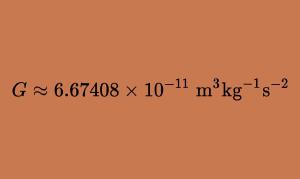Blog
A Subtle Attraction
6 September 2018
 Brian Koberlein
Brian KoberleinIn the depths of empty space, a single electron and a single proton float a few meters apart. Their electric charges create a force on each charge that pulls them toward each other. The force is so small it can be difficult to measure. But the force of gravity is even smaller. For two masses to be pulled with a force as strong as that of the electron and proton, they would have to have the mass of a couple of skyscrapers.
The pull of gravity is extraordinarily subtle. We only notice it because we happen to live on a giant rock we call Earth. For this reason, the precise strength of gravity is still a bit of a mystery. In physics, this strenght is determined by the universal constant of gravity, or G. The value of G determines the strenght of gravity. Despite its importance, the official value of G is only certain to within 5 parts in 100,000. That’s pretty poor accuracy for a universal physical constant.
And even the official value has issues. The offical value is determined by the Committee on Data of the International Council for Science. In 2014 they assigned the current value based upon the best measurements of G we had at the time. It’s known as the CODATA 2014 value. But unlike most physical constant results, several recent measures of G don’t agree with the official value. Some are a bit larger and some smaller. If the offical value covered all recent results, it would only be accurate to 5 parts in 10,000. In other words, we aren’t entirely sure what the value of G actually is.
The hope has been that new experiments would solve the problem. If only we had more precise measurements, the problem would be solved. And recently two measurements of G were made with the greatest precision ever1. The experiment used a very precise pendulum swinging near two masses. By adjusting the distance and position of the masses, the value of G could be calculated with an accuracy of 11 parts per million. That would be great, were it not for the fact that the two results don’t agree with each other.
Although the two new experiments were very precise, they aren’t accurate. Even taking their uncertainties into account, they don’t agree with each other. They do both agree with the much less accurate “official” value, but they can’t help us improve the known value of G. And the fact that these two similar experiments disagree is a bit troubling. Done properly, they should agree, and that means either we don’t entirely understand the uncertainties of the experiments, or gravity is much more subtle than we feared.
Li, Qing, et al. Measurements of the gravitational constant using two independent methods. Nature 560.7720 (2018): 582. ↩︎